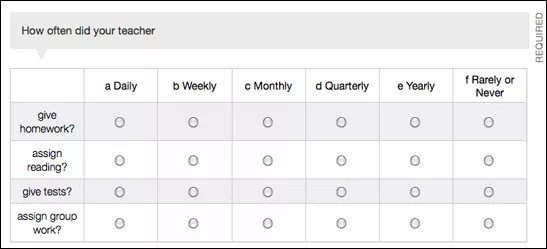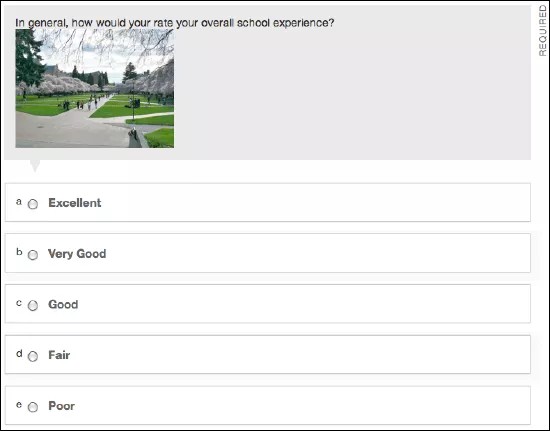Create and Design Enterprise Surveys
Create an Enterprise Survey
Creating a new survey is a multi-step process. Providing descriptive survey information helps you share your survey with other users and helps others to understand the content and purpose of the survey.
- Select Create Survey.
- Type a Survey Name.
- Type an optional Description that appears with the survey name in the list of surveys available to you.
- Select Do not allow backtracking if you do not want to allow recipients to return to previous questions.
- Select Submit. The Design Survey page appears. Next, create questions and customize the look of the survey.
To edit the enterprise survey after submitting, go to the Enterprise Surveys page, open the menu, and select Edit Survey Information.
After you create an enterprise survey, design the way it is presented to recipients. Add questions, customize the header or footer, and insert visual elements such as instructions, section breaks, and page breaks. All survey elements can be arranged with the drag-and-drop feature. Select Preview to see how the survey looks to recipients.
Edit the header and footer
The header appears at the top of all pages in the survey. The footer appears at the bottom of all pages in the survey and is a good location for copyright information, authoring information, and links to privacy and data collection policies.
- Open the menu for an existing survey and select Design Survey.
- On the design survey page, open the menu for Edit Header or Add Footer.
- Select Edit or Add.
- Use the content editor to format the text, insert images, add links, and embed media.
- Select Submit.
Create questions
Point to Create Question and select a question type. Consider these factors as you select the types of questions to add.
- What you are trying to measure?
- How long will it take recipients to complete the survey?
- How do you want to compare and report on the submission data?
To form a rating scale, you can specify point values for all answer choices for all question types. The points contribute to a numerical rating for each answer. The ratings are an average of all responses and appear in analysis reports. The rating can be used to rank responses and make comparisons.
You can add tags to questions so that you can group questions during the analysis. For example, a set of questions in a course survey can be tagged with the label Student Satisfaction and another set can be tagged with Teacher Performance. These sets of questions can then be grouped based on the tags and compared.
Question types
Likert scale
Likert scale questions ask respondents to indicate where their response falls in the range provided in the scale. Creating a Likert scale question is a two-step process. First, select one of the existing scales or make your own, then type the question.
Matrix
Matrix questions are designed to measure a set of related actions using the same scale. Matrix questions combine questions, which shortens the time it takes to complete the survey. When you create the question you select a scale, type a general question, and add a set of related actions.
Multiple choice
Multiple choice questions have a lot of flexibility. Use them whenever you want to provide recipients with the option of selecting more than one answer. Questions can include formatted text, links, attachments, images, and multimedia.
Images and files used in enterprise surveys are publicly accessible. Please take care not to include files or images with sensitive or private information.
Either/or
Either/Or questions ask respondents to select one of two options such as Yes or No, True or False, Agree or Disagree. Use one of the default answer sets or create your own.
Open entry
Open entry questions ask respondents to type in an answer in the text box provided. Answers can be set to accept short responses up to 255 characters or long responses up to 1000 characters.
Format survey with visual elements
Point to Create Visual Element and select one of these elements:
- Instructions: Provide as many sets of instructions as needed to help respondents answer questions or groups of questions. Use the content editor to format the text, insert images, add links, and embed media. New instructions appear at the bottom of a survey. Drag them into place.
- Section Break: Inserting a section break adds a label to a group of questions, giving respondents context around the questions. This helps respondents provide quality answers if the survey spans several topics. You can select Start section on new page if you want the section break to also function as a page break. New section breaks appear at the bottom of a survey. Drag them into place.
- Page Break: Adding page breaks to the survey limits scrolling for respondents and allows them to focus on a few questions at a time. When you add a page break, a Next Page button appears at the bottom of the survey. If you've allowed backtracking in the survey information, a Previous Page button also appears. New page breaks appear at the bottom of a survey. Drag them into place.


